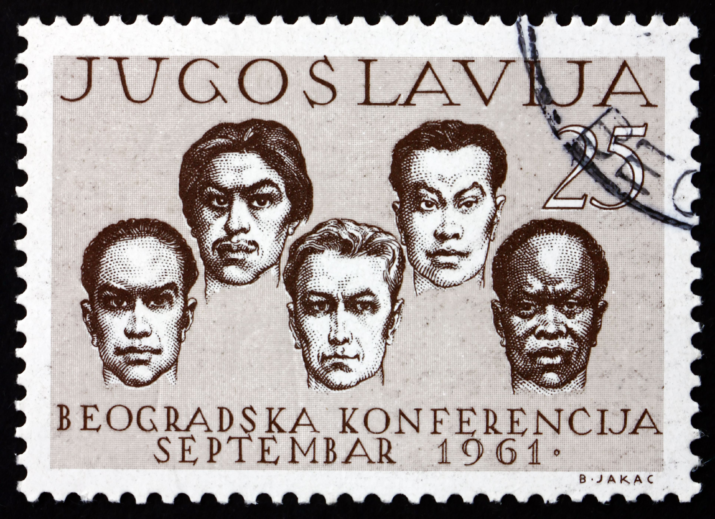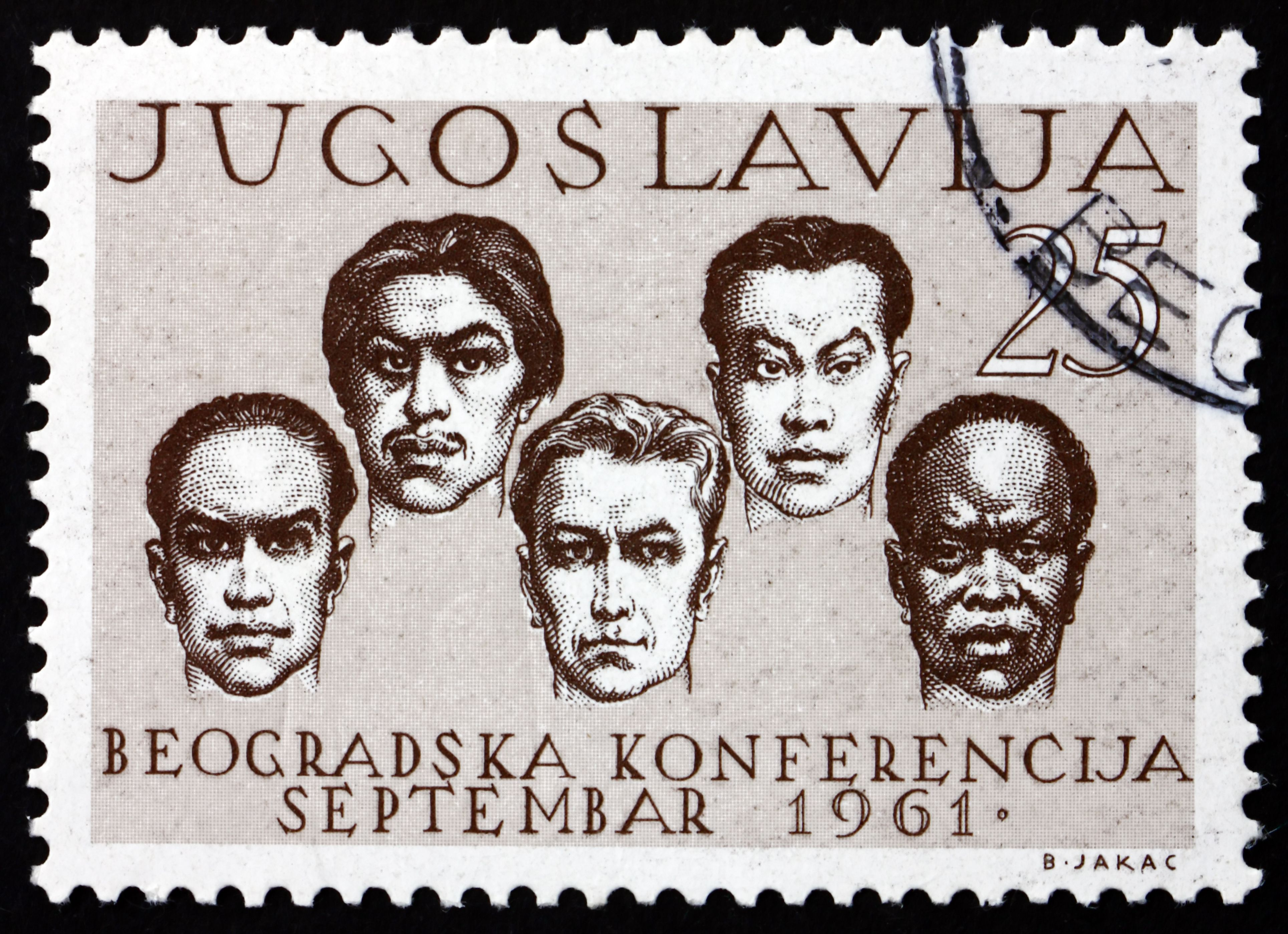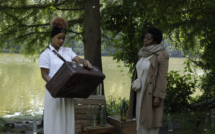

This is part of our special feature, Decolonizing European Memory Cultures.
In the summer of 2021, I was invited by Marija Aleksić, the director of the Museum of African Art – the Veda and Dr Zdravko Pečar Collection in Belgrade, Serbia (MAU), and curators Emilia Epštajn and Ana Knežević to join in the process of museum renovation. Opened in 1977, the MAU billed itself as the only “anti-colonial museum” exhibiting African art in Europe in the spirit of solidarity with newly independent countries on the African continent. Such an ideological stance was closely related to non-alignment, which defined the socialist Yugoslavia’s foreign policy in the 1960s and 1970s. This vestige of socialist anti-colonialism offers an interesting case study for museum professionals and scholars today who wrestle with the question of how to decolonize museums. However, this self-proclaimed anti-colonial museum from the beginning left me ambivalent about the ways in which it broke with but also perpetuated the imperial and colonial episteme. While I tapped into its nonaligned and anti-colonial legacy, I nevertheless remained critical toward the very possibility of creating an anti-colonial museum. Last year’s endeavor in collaboration with the MAU’s curators resulted in the exhibition “An Anticolonial Museum”[1] (September of 2022 to January 2023), which was followed by a conference bearing the same title (October 2022). By asking how we decolonize an anti-colonial museum, the team ultimately registered doubt about the premise that all European museums ought to be decolonized in the same way.
My reflections in this essay are informed by my collaborative work with the MAU not only over the last two years but over twenty years of continuous engagement. My work can be best described as a long-term institutional critique based on translating theory into practice and vice versa. Over the last decade, in particular, I aimed to thoroughly rethink all of the museum’s aspects, not least the process of knowledge production within the field of heritage, which is hierarchically structured even in this museum, despite its egalitarian aspirations as an anti-colonial institution. In my book on the topic of museums and the representation of African art with a focus on the MAU, I argued that this museum defined its anti-colonial stance by distancing itself from Western-type collections that were formed from “colonial plunder.”[2] In order to emphasize such difference, all the objects in the collection were said to have been acquired with permits from the countries of origin. However, the very act of collecting already harbored a colonial discourse. The expertise established by the art market, galleries, and museums, which the MAU’s collectors relied on as relevant in guiding their choices, led to a detachment of the value of what was construed as “African art” from the agency of African artists, craftswomen, and craftsmen. Museums went so far as to deny the latter any credit in museum labels, often describing an exhibit merely as “the work of unknown African.” To produce and reproduce expertise in such a way perpetuated the coloniality of knowledge. Nevertheless, this aspect of collecting was not grasped by the founders of the museum. Indeed, they felt that bringing the collection within the prevailing (Western) canon of African art, while abiding by all the regulations of ethical collecting, would legitimize the museum internationally.
This museum’s permanent display was characterized by an “ethnographic” approach, mainly due to the efforts of the first director Jelena Aranđelović Lazić, an ethnologist herself. Remaining largely unchanged since 1977, the display became the MAU’s most distinctive feature in the meantime. It was built according to the plans of the ingenious designer duo, architects Slobodan Mašić and Saveta Mašić. They devised the exhibition around repeating, triangular-based modular plinths colored in bright blue and green. However, while such display visually signaled a departure from both the white cube and the crammed showcases of nineteenth century ethnographic displays, the anti-colonial message was not immediately readable within the museum.
Besides this largely ethnographic set-up, contemporary art from African countries was represented within the MAU exhibitions as well. Some of the leading names in modern and contemporary African art can be spotted in the MAU’s catalogues from the 1980s, among them Twins Seven Seven, Yinka Adeyemi, and Jimoh Buraimoh from Nigeria, as well as Kofi Antubam, Nii Amon Kotei, and Albert Osabu Bartimeus from Ghana. Their artwork was part of exchange exhibitions organized in collaboration with museums and Africanists such as Boris Kuhar from the Slovene Ethnographic Museum in Ljubljana, Slovenia; Kwasi Myles, director of the National Museum of Ghana in Accra, whose contribution is published in the MAU first catalogue; and collectors such as Drago Muvrin from Zagreb. The strategy of combining ethnographic and contemporary art exhibits—which numerous ethnographic museums worldwide would embrace only at the turn of the twenty-first century—was later criticized as a form of ethnographization itself. However, the MAU understood itself as a cultural and educational center that early on experimented with different formats of representation. That will to experiment was its hallmark for several decades.
Breaking down the MAU’s colonial and anti-colonial features adds clarity:
| Colonial models of representation | Anti-colonial discourse |
| Anonymity of author and ethnic classification of an object | Attribution of the artworks |
| Atemporality of the collection or petrification of the meaning within an imaginary primal community | Introduction of contemporary artists |
| Ignoring of urban forms of visual expression | Inclusion of other, more diverse contemporary art forms |
| Synecdochic representation of the whole by its part (one tribe—one style[3]) | Introduction of other perspectives on seeing and interpreting |
| Static quality of the display | Animated display (film, music, and movement) |
| Ethnographic labels and display texts | Open debates and talks |
The anti-colonial aspect of the museum was mainly anchored in the prevailing socialist and nonaligned discourse of the time. It does not come as a surprise that, once such narratives had been effaced from the more general social and political discourse of the 1990s, they were removed from the MAU as well. A significant shift in values occurred during that decade. The end of the Cold War era, together with the outbreak of wars in the ex-Yugoslav region, effected a distance toward the Yugoslav legacy altogether. The 2000s, however, marked a renewed interest in nonalignment and anti-colonialism that gradually gained momentum, both regionally and internationally. The first exhibition at the MAU that delved into notions of the coloniality of African art reception and representation from the end of the nineteenth century to the 1960s was “Black Body, White Masks,” curated in 2004 by Dejan Sretenović, former chief curator at the Museum of Contemporary Art in Belgrade (MSUB). By opening questions about the coloniality of knowledge, it also brought back into the spotlight the history of socialist Yugoslavia and its solidarity with newly independent African countries. Especially from the 2010s on, accounts about the anti-colonial past, rather than merely signifying a historical period, became part of a search for alternative ways of imagining the future in a present in which alternatives seemed to have become rather scarce. While the MAU may take pride in being a beacon of decolonizing endeavors, I wish to emphasize that the anti-colonial discourse that we point at today when talking about the MAU is fraught with the discontinuities and tensions I have outlined. The recognition and recuperation of the values of anti-colonialism, anti-racism, and solidarity resulted from the continuous and collaborative work of numerous theorists, artists, and curators, outside of and inside the museum, locally and internationally, who sought to bring those values back into the public sphere.
Within the last decade, a number of programs aimed to rethink such museal ambiguities and both insiders and outsiders worked to develop criticism of the museum. In particular, the open-concept talks “Contexts and Representations” (2014-2018) that took place in the permanent display and in other venues within the museum guided that rethinking. Both the talks and the subsequent exhibition, “Nyimpa kor ndizidzi, (Re)conceptualization of the Museum of African Art, the Veda and Dr Zdravko Pečar Collection” (NKN), were co-curated by the MAU’s curator Emilia Epštajn and myself as an independent curator.[4] For the purpose of the exhibition NKN, we engaged in revealing the invisible, unrecognized anti-colonial elements that were already in the museum but had not been previously understood as important, or even formally acknowledged—most notably artifacts belonging to the documentation bequeathed by Veda Zagorac and Zdravko Pečar. Both figures had been prominent supporters of the Algerian anti-colonial struggle. Zdravko Pečar, a Yugoslav reporter, clandestinely crossed the infamous border called the Morice line between Algeria and Tunisia along with guerilla fighters to convey first-hand accounts from the Algerian side of the war. At the same time, Veda Zagorac was appointed as a cultural attaché in the Yugoslav embassy in Tunisia, facilitating among other things the publishing of three collected volumes of the Algerian revolutionary paper El Moudjahid in Yugoslavia.
Relying on documents and objects from the museum’s secondary or informal collections, and therefore pointing at museums behind/within the museum, the exhibition NKN showed in practice how the values of an institution shift depending on discourse. Different and sometimes dissonant standpoints were accentuated in the accompanying book, which included contributions by MAU curators (Milica Josimov, Ana Knežević, Marija Ličina, Dragan Mišković, Milica Naumov, Nataša Njegovanović Ristić, Aleksandra Prodanović Bojović, and Ivana Vojt) and in which selected theorists participated (Marijana Cvetković, Olivier Hadouchi, Vladimir Jerić Vlidi, Miroslava Lukić Krstanović, Nemanja Radonjić, Dejan Sretenović, and Jelena Vesić). Among them, Olivier Hadouchi provided a re-evaluation of photographs taken by Zdravko Pečar and presumably by Abdelkader Laribi, which were kept at the MAU. Hadouchi’s research on the topic had been published the previous year as part of the international project “Non-aligned Modernisms.”[5] In his book Images of Non-Aligned and Tricontinental Struggles, he emphasized that these photographs were a rare visual account of the Algerian war for independence that did not show participants in staged heroic poses but rather recorded the sometimes long and slow hours between military actions. It would not be an overstatement to say that Veda Zagorac and Zdravko Pečar are in fact the bearers of the anti-colonial discourse at the MAU. In their dedication to anti-colonial struggle, we can recognize reflections of their sentiment about the Yugoslav liberation struggle during WWII. Historian Nemanja Radonjić contributed to the book NKN by thoroughly reconstructing the lives of both Veda Zagorac and Zdravko Pečar, whose erasure from museum narratives had to do with the historical amnesia of the 1990s. Obscuring the protagonists of the Yugoslav socialist revolution particularly affected women who were active communists and partisans, such as Veda Zagorac, as Emilia Epštajn emphasized in her work. However, the role of women in art and culture and their consecutive effacement is a topic that a number of artists and theorists worldwide currently tackle in the form of recuperated knowledge and secondary archives. This case as well has to be observed within global regimes of in/visibility that continue to privilege some protagonists, facts, and narratives over others.
At the museum, the string of exhibitions concentrating on nonalignment and anti-colonialism continued with “Non-aligned World” (curated by Radonjić, Knežević, Epštajn and Naumov) and “This is not a War—The Liberation of Mind and Land, in Ink and in Action” (curated by Epštajn and Knežević), both in 2021. From the point of view of a thorough criticism of museums and heritage in general, however, the fixation on “re-discovered” anti-colonial archives or collections in the form of various documents—although recuperation of such knowledge is important—can be misleading. If we continue to focus on the time-capsule quality of the place and its newly recognized objects rather than the models of museum knowledge production, the most we can achieve is a correction. Moreover, by knowledge production I mean the very framework within which museums establish and normalize different hierarchies, from hierarchies of time, space, data, protagonists, and narratives, to consequent hierarchies of one life understood as more or less valued than the next one.
Therefore, I propose that we understand the term “anti-colonial,” as laid out in the exhibition “An Anticolonial Museum,” in at least two ways. First, the term indicates the significance of nuanced institutional histories that do not allow for all institutions to be decolonized in the same way, in particular if those institutions were already imagined as revolutionary and anti-colonial. Second, the term can be understood as a critical platform, placing an invitation before museums, which are highly political and ideological institutions, to openly declare the values by which they stand and to act in real time in facing today’s pressing social issues, thus embracing their social responsibility.
In relation to both of these meanings, one particular aspect must be considered: the affective heritage of constituencies– meaning all the people who are personally invested in this institution– that is related to this very place as a place of memory.[6] I am referring to the fact that the values of anti-colonialism, anti-racism, and solidarity, which have not been inscribed in the visual appearance of MAU nor on the museum’s labels or wall texts over the last forty-five years, remained present in the people. There are certain communities in Belgrade that experienced this institution as their own, based on shared values. Among them are the Africans living in Belgrade, professionals who used to live and work in African countries, children and grandchildren of families and marriages that were a direct result of the mobility caused by nonalignment, all those who did not cease to identify with values of socialist Yugoslavia, and many others whom other institutions of heritage and culture did not recognize as subjects.
In post-2000 Serbia, such affective attachments clashed with the prevailing nationalist narratives. Indeed, during that period, the MAU, along with the Museum of Yugoslav History in Belgrade (MYH, which changed its name to Museum of Yugoslavia in 2016), presented marginalized cultural spaces. Most of the sentiment in relation to Yugoslav heritage, of which the MAU was a part, was described back then as nostalgia, pointing at some affective engagement of a lower order and often understood as outdated. Not much attention was given to how constitutive and in fact crucial the construction of heritage was to a sense of self and to how the rupture in historical narrative, and therefore heritage, was also a rupture in autobiographical narrative. Both museums, which recalled socialist Yugoslavia, continued to function somewhat apart from the rest of the political and ideological mainstream. In fact, due to such marginal position, they soon turned into spaces of experimenting with and rethinking not only the specific museums’ content, but also museums as institutions more generally. After all, these institutions were the paramount examples of how changeable, unreliable, and deeply ideological and political heritage is.
Working closely with both museums over decades and questioning what it means to lose a particular heritage and the sense of self that such heritage used to structure and reflect, I had to ask what it means never to be reflected, recognized, nor affirmed by cultural institutions—what it means, therefore, not only to lose social recognition, and consequently a sense of belonging, but to never be recognized as the person that you feel you are. In fact, most museums continue to reproduce hierarchies of power by interpellating individuals to the limited roles and positions available to them within museum structures, often without alternatives. We should consider whether an anti-colonial stance on the part of constituencies might mean the refusal to respond to such an interpellation and therefore a willingness—or even a need—to question the authority that imposes it in the first place.
To reflect on such questions, the MAU organized in August 2022 a series of talks entitled “Towards an anti-colonial museum,” opening the floor for constituencies to express their ideas as to what an anti-colonial museum could be, ahead of the exhibition “An Anticolonial Museum.” These talks were envisaged as an open, nonhierarchical platform for anyone interested in the topic (from general audience to professionals in the field) to reflect on different questions about the ways in which we now understand notions of imperialism, colonialism, racism, decolonization, and neocolonialism. They also raised questions about the coloniality of knowledge, museums as institutions, and the concepts of anti-colonialism, anti-racism, and solidarity. As they imagined the anti-colonial museum, the participants raised many examples of community and belonging. They also delved into the openness of the very question of what an anti-colonial museum should be.
The methodology used in the talks was in accordance with the ideas of the Anticolonial Museum Manifesto, a list of recommendations intended to serve as guidelines for further museum re-thinking that I had presented the year before in a lecture for the TrAIN center at the University of Arts in London, at the invitation of Ewelina Warner and Nela Milić. Partially inspired by ideas laid out by Bojana Piškur, curator at the Museum of Contemporary Art in Ljubljana (MSUM+MG), at the conference “A Non-Aligned Museum,” organized in MYH, Belgrade, in 2016, I proposed that we move beyond the ideas of an object-based museum and toward a more dialogical approach. My recommendations were as follows:
- Delineate the values you stand by, express them clearly, and inscribe them into every segment of your work.
- Set anti-colonial, decolonial, anti-fascist, and anti-racist thinking as main lines in your research, work, exhibiting, and publishing, as well as in your public engagement and actions.
- Do not talk on someone else’s behalf but rather open space for other people to share their points of view on topics that primarily concern them or about which they are knowledgeable.
- Do not use other people as informants but address them as interlocutors, respecting their knowledge and worldviews.
- Establish collaborations with individuals, organizations, and institutions that are not based on the perceived importance of a particular institution within existing hierarchies but rather on the knowledge they can contribute.
- Reconsider the active and changing roles of communities in thinking about heritage and museums by focusing on decentralizing decision-making, use, and care; the current and potential displacement of constituencies; the transformations of socially and legally recognized roles of individuals and groups; or the introduction of previously unrecognized individuals or groups and formal or informal participants, which would affect how both the past and the future are construed.
- Have a longue durée perception of the phenomena with which you engage, threading together past, present, and future in a responsible, conscious manner, but also be aware and critical of your own ideological position over the longue durée.
- Do not only look back or forward; rather, understand the urgency of the moment we find ourselves in and link all of your production to a contemporary articulation of the current state of our society.
Nevertheless, it may come as a disappointment that the impossibility of creating an anti-colonial museum stems from the very foundations of museums and heritage, as these concepts are closely related to modernity and tightly interwoven with coloniality and racism.[7] The very assumption, therefore, that museums and archives constitute the only way to keep and mediate our shared memory—museums certainly continue to present themselves in this vein—is outright arrogant and colonial. Indeed, this assumption continues to be dismissive of other formats and ways of experiencing, knowing, and transmitting knowledge. It is this arrogance, displayed not only by museums but by the whole field of heritage, that is yet to be questioned.
Ana Sladojević is an independent curator and art and media theorist. She has studied museums as complex objects, whose previous discourses, often inscribed within different unrecognized or “invisible” elements, such as the “surplus” of museum production in form of archives, documentation, or study materials, bear influence on how a meaning is formed. She has researched these questions particularly within the context of the Museum of African Art – the Veda and Dr Zdravko Pečar collection and the Museum of Yugoslavia, with an emphasis on certain aspects of these institutions that are related to historical nonalignment.
References
[1] Sladojević, Ana, An Anticolonial Museum, (Belgrade: MAU, 2022).
[2] Sladojević, Ana, Museum as an Image of the Wolrd, the Space of Representation of Identity and Ideology, (Belgrade: Doctoral Thesis, Interdisciplinary Studies, University of Arts in Belgrade, 2012) and Sladojević, Ana, Contexts and Representations, (Belgrade: MAU, 2014).
[3] Kasfir, Sidney Littlefield, “One Tribe, One Style? Paradigms in the Historiography of African Art,” History in Africa, Vol. 11, (Cambridge: Cambridge University Press, 1984), 163-193.
[4] Sladojević, Ana and Emilia Epštajn, eds, Nyimpa kor ndzidzi / One Man No Chop, (Re)conceptualization of the Museum of African Art – the Veda and Dr Zdravko Pečar Collection, (Belgrade: MAU, 2017).
[5] Hadouchi, Olivier, Images of Non-aligned and Tricontinental Struggles, (Belgrade: MSUB, 2016).
[6] https://www.internationaleonline.org/glossary/constituencies/
[7] Mignolo, Walter, “Museums in the colonial horizon of modernity: Fred Wilson’s Mining the museum,” in: Harris, Jonathan, ed., Globalization and Contemporary Art, (Chichester: Wiley-Blackwell), 72-85.
Published on February 21, 2023.




